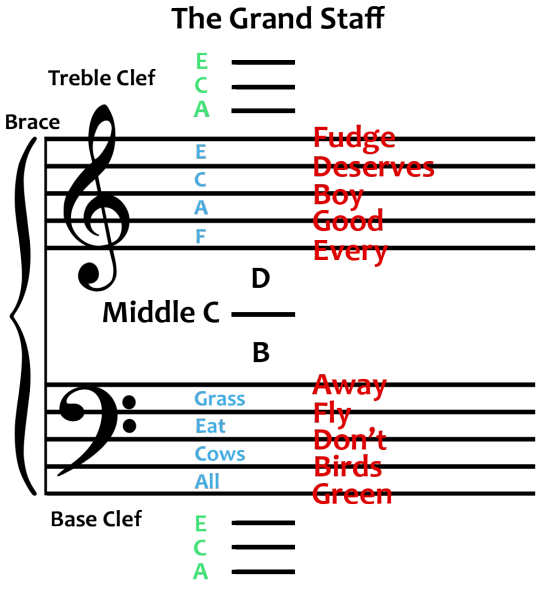Courses
Matching Piano Keys to Sheet Music
Hello and welcome! This course is for absolute beginners looking to learn piano. Andrew Furmanczyk will walk you through the basic information needed to start you off on your musical journey!
1. Intro
Andrew first started taking music lessons at age 5 and earns his living teaching Piano and Music Theory. What you will learn from this course: Names of all white piano keys Basic terms for reading sheet music (Clefs, Staff, Notes) Names of notes on sheet music How to match sheet music notes to white keys on piano. If you don't know anything about piano but would like to start learning, this is a great course to begin with!
2. Learning the Piano Key Names
First thing we are going to learn is the names of the keys on the piano. On a full size piano or keyboard there are 88 keys in total, but learning all 88 keys is quite easy! The keys on the piano repeat using the first 7 letters of the English Alphabet: A, B, C, D, E, F, G. After G, you get back to A and start the whole process over again. Watch the video below next!
2.1 Study time!
Keep in mind that you are learning something new and it's normal to find new information difficult to memorize. It might feel hard, but never give up, keep going, and you'll find you've actually done a great job! There's nothing wrong with making mistakes when you're trying your best. Mistakes are part of how we learn!
Study tip:
To memorize the list below, this method can help: Read the point (with your eyes), Speak the point (with your mouth),Hear the point (with your ears), Think the point (with your mind/imagination). -Read each point aloud, and repeat that point over and over. (10+ times) -Close your eyes and try to visualize an image that helps you remember the point you're trying to memorize. (ridiculous images can be the best for memorization) -Once you have captured the point in your mind, close your eyes and try to repeat it from memory 5 times in a row without a mistake. (you're trying to repeat the phrase without a visual aid) -Memorize each point like this until you've completed the list. -Read the list from beginning to end one last time and see if everything seems secure in your mind. If there is no problem continue on with the test below, I recommend doing it more than once!
Memorize these points:
- A full sized piano or keyboard has 88 keys (52 white keys, 36 black keys)
- The names of the white keys are A, B, C, D, E, F, G. (after G the keys continue to repeat over and over up the piano like this: A, B, C, D, E, F, G, A, B, C, D, E, F, G, A, B, C, D, E, F, G...etc).
- The bottom note on a full size keyboard is usually an A (some keyboards end with a C) and the top note is a C.
- There are 7 groups of 2 and 3 black keys. They help us find our place on the keyboard. Looking for "Middle C"? Find a group of two black keys in the center of the piano (usually located near the branding of the keyboard), then go to the white key directly to the left of the 2 black key group.
List of how to find all white keys:
- C is found to the left of 2 black keys.
- F is found to the left of 3 black keys.
- E is found to the right of 2 black keys.
- B is found to the right of 3 black keys.
- D is found in the middle of the group of 2 black keys.
- G is found to the left of the middle black key in the 3 black key group.
- A is found to the right of the middle black key in the 3 black key group.
3. Learning Key Names on Sheet Music
Now we begin sheet music!
If you're just starting out, sheet music can look pretty scary and complex at first glance, but it is by far the easiest way we know of to record music in a written way. Sheet Music is a system for writing and reading music. The reason we write music down is the same reason we write down a story in a book: so it can be read over and over without changing over time. Being able to play music, but not knowing how to read sheet music can be a huge disadvantage; it's similar to when someone can speak a language but not read or write. (I'm assuming you know how to read considering you're reading this.) Imagine where you would be today in life if you had not learned how to read? Do you regret learning how to read? That's how you'll feel when you learn to read sheet music. It might take a some time to start reading, but it is definitely worth the effort in the long run! Once you spend a little time, you'll see most sheet music is simple to read and can be understood by almost anyone with a little training. You can do this! Let's start! Please watch the videos below.
3.1 This is the "Staff"

Things to remember: The staff has 5 lines and 4 spaces. Think of the staff as the workspace where all other parts of music are placed.
3.2 What are notes?
Notes are basically signals we write on the staff to tell us which pitch to play and how long the sound should last for. They come in different forms, but we'll only be looking at the whole note in detail at this time.
Bonus
Just in case you're curious though, I've included images of what some of the main types of notes in music look like below (this isn't a complete chart by any means).

3.3 Clefs, Grand Staff, and Note sayings.
Things to remember: A "Grand Staff" is essentially two staffs joined together by a brace. Usually the Treble Clef is on top, and the Bass Clef is on the bottom.

Review the sayings and test yourself until you can answer within 3 seconds. Get the answer correct x10 in a row. Treble Clef: Spaces: F A C E, Lines: Every, Good, Boy, Deserves, Fudge Bass Clef: Spaces: All, Cows, Eat, Grass Lines: Green, Birds, Don't, Fly, Away Ledger lines: A C E In the middle: Boat B on the Bass Clef, Center-line C, and Doggie D digging under the fence.
3.4 Reading Notes Correctly
When reading a note: First, which clef is the note on? Second, is the note you're reading on a line or space? Third, recall the correct saying, and determine the note name. Watch the videos below please.
Things to remember: When finding a note: Clef>Line or Space>Saying>Note Name
4. Matching Piano Keys to Notes
Let's Match!
Here's where everything should start to come together! You've done well to get this far. This next part may feel challenging, but you're doing something new, and it's normal for new things to feel difficult at first. You've got this.
Things to remember: When reading, always determine the letter name first. If the note happens to be a G, then the next step is to figure out which G it is on the keyboard. To figure out which G is the correct one on the keyboard, use other keys like "Middle C" as landmarks. Then think your way through logically to find the actual location of the key by using the landmarks as a reference.
If you don't know an answer, it's important to keep cool and figure out the problem step by step. Not knowing the answer only means there's something you need to review a little more, no worries! If you have to go to an earlier lesson to review some of the material, no big deal! Take a step back, regroup, and come back to show this test who the boss is! Once again, this is a skill like anything else, and more practice will help you improve your speed. Expect to be fairly slow at the start, but with half an hour each day for a week you should see big improvements in your speed! Once you can read quickly, this is GREAT! You can use your ability to read the notes to your favorite songs faster than before. Eventually, you can get so fast at reading that you can read as fast as you play. Reading while playing is called "Sight Reading". If you can sight read great, then you can play new music you've never played before as you see it. There are more tricks for improving speed such as intervallic reading, but first you must master reading note by note, so study hard!
5. Final Thoughts
You made it to the end! Great job!
Where do you go from here you might ask? Well, you'll want to nurture these skill you've picked up over the next few weeks so that they stay locked in your brain. The next things you'll want to learn depends on what your goals are, but one obvious thing to learn next is the black keys. To do this you'll need to learn about, Semi-tones and Whole-tones, as well as Sharps and Flats. I have already made a course in the past that covers these topics (Although it is a little older now, the information is still correct.). It's a great place to go from here! Watch the course.
Thanks for watching and I hope you found this course helpful!